

Robert Ellis Dunn. Trisha Brown: Talking Art and Dance — Trisha Brown: Talking Art and Dance — Channel. Accumulation with Talking plus Water Motor- Trisha Brown. Trisha Brown's Sololos (1976) and Watermotor (1978) Deborah Hay responds to 9 Evenings (excerpt from the DVD series, 9 evenings: theatre & engineering) Tony Orrico: Penwald: 4: unison symmetry standing. Penwald: 4: unison symmetry standing (Flux/S at Strijp-S, Eindhoven, NL) 2010. Motione. AME Research. Teaching 21st century proficiencies in high schools by engaging students in creative digital projects David Tinapple Loren Olson A goal of the newly created Digital Culture program at ASU is to bring the proficiency-based curriculum designed for our undergraduates, to middle and high school classrooms. we believe that skills such as computational thinking, collaboration, creativity and innovation, and information literacy can be taught in a highly effective way by using aesthetic challenges as a motivation.
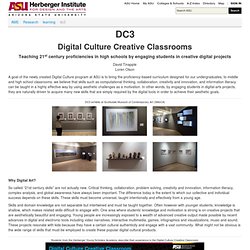
In other words, by engaging students in digital-arts projects, they are naturally driven to acquire many new skills that are simply required by the digital tools in order to achieve their aesthetic goals. DC3 exhibits at Scottsdale Museum of Contemporary Art (SMoCA) Why Digital Art? So called “21st century skills” are not actually new. Dance Forms. Rhonda Ryman's Ballet Moves II All English ballet sequences from the first edition have been updated with new dance figures and metronome beats.
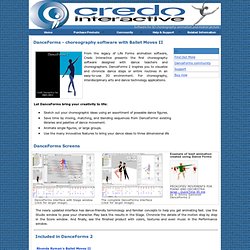
Ballet Moves II features brand-new content, including a complete Russian Dance library and selected palettes & motions from the Italian school. Modern Dance moves A library of Modern Dance content. Choreography and Cognition - Home. Eadweard Muybridge. In 1874 he shot and killed Major Harry Larkyns, his wife's lover, but was acquitted in a jury trial on the grounds of justifiable homicide.[3] He travelled for more than a year in Central America on a photographic expedition in 1875.
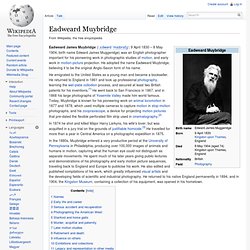
In the 1880s, Muybridge entered a very productive period at the University of Pennsylvania in Philadelphia, producing over 100,000 images of animals and humans in motion, capturing what the human eye could not distinguish as separate movements. He spent much of his later years giving public lectures and demonstrations of his photography and early motion picture sequences, traveling back to England and Europe to publicise his work. He also edited and published compilations of his work, which greatly influenced visual artists and the developing fields of scientific and industrial photography. He returned to his native England permanently in 1894, and in 1904, the Kingston Museum, containing a collection of his equipment, was opened in his hometown. Eadweard Muybridge: Naked Truths. Loie Fuller, danse serpentine.
1894 - Annabelle Butterfly Dance - William K.L. Dickson. Leon Theremin playing his own instrument. Video tracking. Objective[edit] The objective of video tracking is to associate target objects in consecutive video frames.

The association can be especially difficult when the objects are moving fast relative to the frame rate. Another situation that increases the complexity of the problem is when the tracked object changes orientation over time. For these situations video tracking systems usually employ a motion model which describes how the image of the target might change for different possible motions of the object. Examples of simple motion models are: Algorithms[edit] To perform video tracking an algorithm analyzes sequential video frames and outputs the movement of targets between the frames.
Target representation and localization is mostly a bottom-up process. Filtering and data association is mostly a top-down process, which involves incorporating prior information about the scene or object, dealing with object dynamics, and evaluation of different hypotheses. See also[edit] External links[edit] Very Nervous System (1982-1991) by David Rokeby. Gideon Obarzanek on Glow and Mortal Engine, New York. Motion capture. Motion capture of two pianists' fingers playing the same piece (slow motion, no sound).[1] Camera movements can also be motion captured so that a virtual camera in the scene will pan, tilt, or dolly around the stage driven by a camera operator while the actor is performing, and the motion capture system can capture the camera and props as well as the actor's performance.
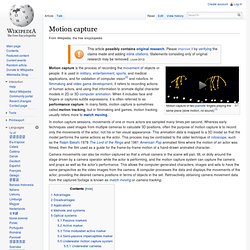
This allows the computer-generated characters, images and sets to have the same perspective as the video images from the camera. Physical computing. Physical computing, in the broadest sense, means building interactive physical systems by the use of software and hardware that can sense and respond to the analog world.
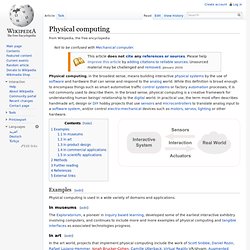
While this definition is broad enough to encompass things such as smart automotive traffic control systems or factory automation processes, it is not commonly used to describe them. In the broad sense, physical computing is a creative framework for understanding human beings' relationship to the digital world. In Plane (1994) by Troika Ranch (USA) Reactor for Awareness in Motion Yoko Ando and Cyril Baldy with Scene "Line" In this movie, dancers react to the information from "Line" which is one of the "scenes" are previously programmed environmental conditions in "RAM Dance Toolkit".

The scenes provide the dancer with a way to recognize their subconscious movements by altering the dimensions of our everyday physical perception and creating a disparity from what we are used to. They inspire new ideas for dance. Étienne-Jules Marey. Flying pelican captured by Marey around 1882.
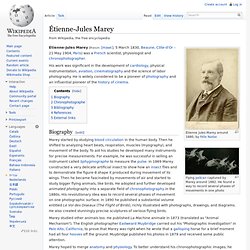
He found a way to record several phases of movements in one photo Étienne-Jules Marey (French: [maʁɛ]; 5 March 1830, Beaune, Côte-d'Or – 21 May 1904, Paris) was a French scientist, physiologist and chronophotographer. His work was significant in the development of cardiology, physical instrumentation, aviation, cinematography and the science of labor photography.